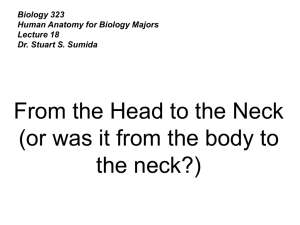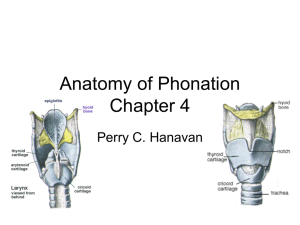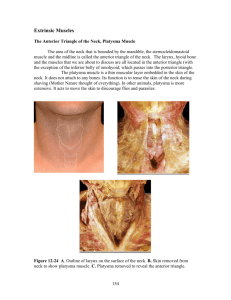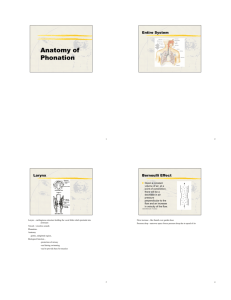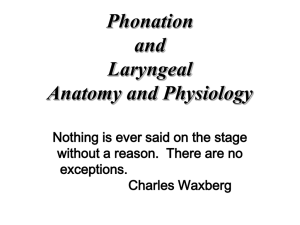lecture 10
advertisement
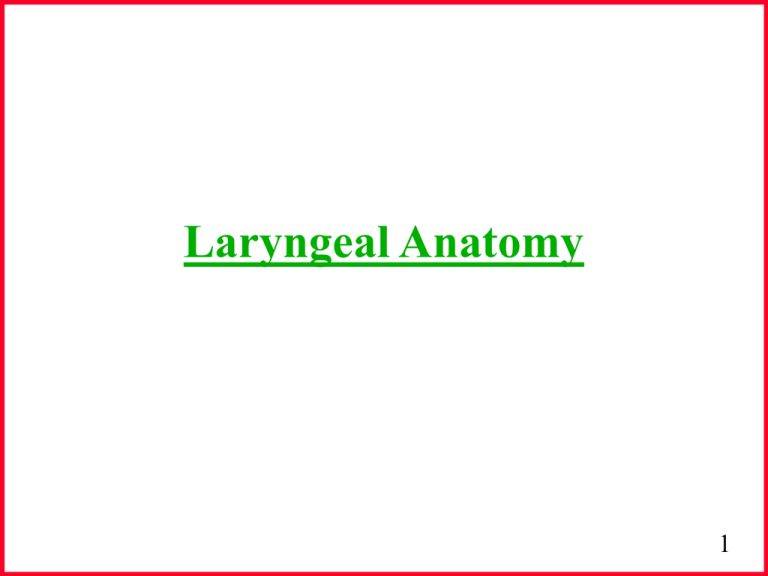
Laryngeal Anatomy 1 Extrinsic Laryngeal Muscles • Three Main Purposes: 1) Fixation (primary role) 2) Elevation (move larynx up) 3) Depression (move larynx down) • Two major groups of extrinsic muscles Suprahyoid & Infrahyoid • Anatomical position: Suprahyoid- one of the above attachments lies above the larynx. Infrahyoid- one of the attachments lies below the larynx. 2 Extrinsic Laryngeal Muscles • Suprahyoid Muscles: 1) Digastric 2) Geniohyoid 3) Hyoglossus 4) Mylohyoid 5) Stylohyoid • Function: Raise the hyoid bone & indirectly raise the larynx. 3 Digastric • Two fleshy bellies • Anterior belly- originates from the inside surface of the lower border of the mandible near the symphysis and inserts into the lesser horn of the hyoid bone • Posterior belly- Originate from the mastoid process of the temporal bone to the sternocleidomastoid muscle • Two bellies meet and are joined by an intermediate tendon • Contraction raises hyoid or if hyoid is fixed, may assist in depressing lower jaw 4 Stylohyoid • Superficial to the diagastric • Originates from posterior and lateral surface of the styloid process of the temporal bone & inserts into hyoid bone • Contraction draws the hyoid bone up and backward 5 Mylohyoid • Forms muscular floor of mouth • Originate from the mylohyoid line (inner surface of mandible) • Fibers coarse medially and downward and join the other paired muscle at the raphe • Posterior fibers attach right to hyoid bone • Contraction elevates the hyoid, floor of mouth and tongue • Hyoid fixed, may assist in depressing mandible 6 Geniohyoid • Paired, cylindrical muscle located above the superior surface of the mylohyoid muscle • Originate by means of a short tendon, from the lower part of the mental symphysis • Insert into anterior surface of the hyoid • Mandible fixed, this muscle pulls the hyoid bone up and forward 7 Hyoglossus • Extrinsic muscle of the tongue • Influences position of the larynx • Arises from upper border of the body and greater horns of the hyoid bone • Inserts into posterior and lateral regions of the tongue 8 Genioglossus • Extrinsic tongue muscle which influences position of the larynx • Originates from the mental symphysis • Fibers fan out and course toward their insertion • Lower fibers insert into the body of the hyoid bone • Upper fibers insert into the under surface of the tongue • Contraction elevates the hyoid bone and draws it 9 forward • Infrahyoid Muscles: 1) Sternohyoid 2) Omohyoid 3) Sternothyroid *All are considered laryngeal depressors 10 Sternohyoid • Flat muscle lying on the anterior surface of the neck • Originates from the posterior surface of the manubrium of the sternum from the medial end of the clavicle and from the ligamentus tissue • Fibers coarse vertically and insert on the lower border of the body of the hyoid • Acts to draw the hyoid bone downward and fixes the hyoid when the lower jaw is open against resistance 11 Omohyoid • Long, narrow 2 bellied muscle • Located on the anterolateral surface of the neck • Inferior belly originates from the upper horn of the hyoid • Prevents the neck region from collapsing during deep inspiration • Prevents blood vessels of the neck from being compressed 12 Extrinsic laryngeal Muscles Mandible Ant. Digastric Post. Digastric Stylohyoid Mastoid Tip Mylohyoid Hyoid Bone Thyrohyoid Sternohyoid Omohyoid Sternothyroid Sternum 13 Intrinsic Laryngeal Muscles • Functions: 1) Abduction of the vocal folds for respiration, 2) Fine discrete movements during voice production & closure of the vocal folds and, 3) Protection of the trachea. 14 More Specifically... • change the degree of abduction/ adduction • change the mass characteristics of the folds • change the tension of the folds • change the length characteristics of the folds • react during swallowing- closure of folds • assist in muscular mechanical advantage 15 Intrinsic Muscles: Action of Cricothyroid Pars oblique Pars recta • Cricothyroid: fan-shaped, 2 divisions, Lengthens & tenses the vocal folds. 16 Intrinsic Muscles Thyroarytenoid Vocal ligament Thyrovocalis Thyromuscularis • Thyroarytenoid: muscle making up the true vocal folds, 2 parts: thyrovocalis (bound to the vocal ligament) & thyromuscularis (lateral to arytenoids). 17 Thyroarytenoid Functions • decreases the distance between the thyroid & arytenoid cartilage's, • shortens the folds, • decreases tension • decreases pitch of the voice, • active contraction lowers pitch of the voice. 18 Intrinsic Muscles Action of Post. Cricoarytenoid Posterior Cricoarytenoid • Posterior Cricoarytenoid: Abducts the vocal folds, actively contracted at the end of phonation & any speech sound not requiring v.f. vibration. 19 Intrinsic Muscles Action of Lat. Cricoarytenoid Lateral Cricoarytenoid • Lateral Cricoarytenoid: lies along upper surface of cricoid cartilage, adducts vocal processes of arytenoids closing membranous portion of v.f.’s. 20 Intrinsic Muscles Transverse Interarytenoids Oblique Interarytenoids • Interarytenoids (transverse & oblique): Unpaired, 2 part muscle, adducts the v.f.’s in the cartilaginous portion by pulling arytenoid tips together. 21 The Glottis Glottis • • • • The glottis is an open space between the vocal folds. Size is dependent on what position the v.f.’s are in. Not a muscle or cartilage. Abduction- open v.f.’s; Adduction- closed v.f.’s 22 Ventricular Folds • Otherwise know as the False Folds, • superior & lateral to the true vocal folds, • Their role in phonation? -No role in voicing • consist of muscle, but doesn’t have innervation for discrete movements, • Hyperfunctional voice? 23 Activity 1) With you mouth open, hold your breath, then abruptly release it with a vocal tone. What physiologic events occur at the glottis? 2) Produce an /h/ sound alone. What is the status of the glottis? How did it get there? 3) Produce an /h/ sound, then slide into phonation. What muscles are contracting to affect what conditions in the glottis? 24 More questions... 1) Place your finger on the laryngeal prominence, alternate between high and low pitched tones. Can you identify a change in the position of the larynx and describe the prime movers? 2) Can you phonate while inhaling? What are the physiological differences? 25 Reading/Assignments • Seikel: Pgs. 183-202 • Dickson: Pgs. 160-176 26
